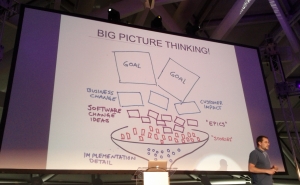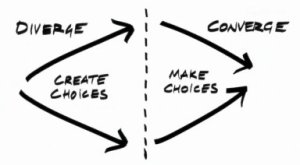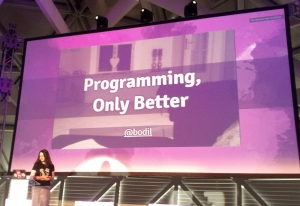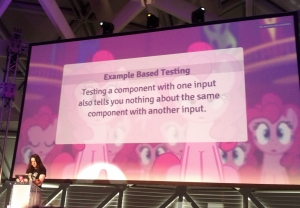First of all, I’m a big fan of Gojko’s work. I’m constantly trying to contaminate people around me and ask them to read Impact Mapping which I think might be a super duper solution to lesser the gap between IT and business people (and this is just one advantage amongst others! Just read it :-) ).
This presentation was not (only) about Impact Mapping, though, but more on how to write better User Stories. Gojko showed us how by spending 10 minutes more on writing user stories, they could be 10.000 times better :-)
The fact: our systems lack on flexibility. And that’s pretty strange, because this is always something people are searching for. Most of the time they’re even OK to pay more for flexibility (think about train of flight tickets that are much more expensive with some flexible options).
Systems are often built with a lack of flexibility and when their limits are reached people get into a crisis situation where the only possible option to keep the business alive is to Think & Redesign the whole system (and Measure if they’ve built it the right way this time!). But why wait for a crisis or chaos to do things the right way? Wouldn’t it be simpler to do it from the beginning? Make sense, uh? Jez Humble wrote about “Does Systemic Change Require a Crisis?” in his Lean Enterprise book. He quoted “The Corporate Culture Survival Guide” book by Edgar Schein. Pretty interesting.
Ok, so we should think about flexibility sooner. But keep in mind that trying to have a flexible scope is impossible without having a big picture of the goal to reach. User Stories are often disconnected from real business needs. Why? Because business people like to write what they would like to have on Power Point slides, not by saying things like “as a user I want this or that”.
Tim Hartford wrote the Adapt book, where he tells us about the Palchinsky principles. As stated here: “Peter Palchinsky was born in 1875. He was a mining engineer who wished to take a more humanitarian approach to engineering […] He argued that Russian engineers did not approach problems in an “academic-dilettantish” way. Instead, they took on every problem as a purely technical one and assumed that if a solution incorporated the latest science, then it was the best solution”. Does this remember you something? Doesn’t it sound pretty familiar with what we’re experiencing today? Palchinsky said that linear plans never works because they do not consider Local, Time and Human dimensions. What would that mean? Well, did I tell you to read Impact Mapping yet? ;-)
So, how to take those dimensions into account? Think about:
- Variation: search for ideas and try new things…
- Survivability: …on a survivable scale, meaning where failure is survivable for your company….
- Selection: … and get rid of those which do not work! (A/B test, monitoring, …), learn from your mistakes!
We somehow have to create a GPS for our apps! And as a GPS system would do, replan in case of problems! User Stories should somehow include the “excepted time for arrival” information!
How could we apply the 3 dimensions above in our User Stories? Here’s Gojko’s advice:
- Variation: Plan to learn! US should not be commitments but options! We definitely need to change our mental perception of US. Use what Tim Brown says in “Change by Design
”: create options during what he calls a divergent phase and then make choices during the convergent phase.
© Tim Brown
- Selection: Plan to discard mistakes: put a victory condition on your User Stories.
- Survivability: Plan not to kill your company :-) Great User Stories are survivable experiments!
More links:






